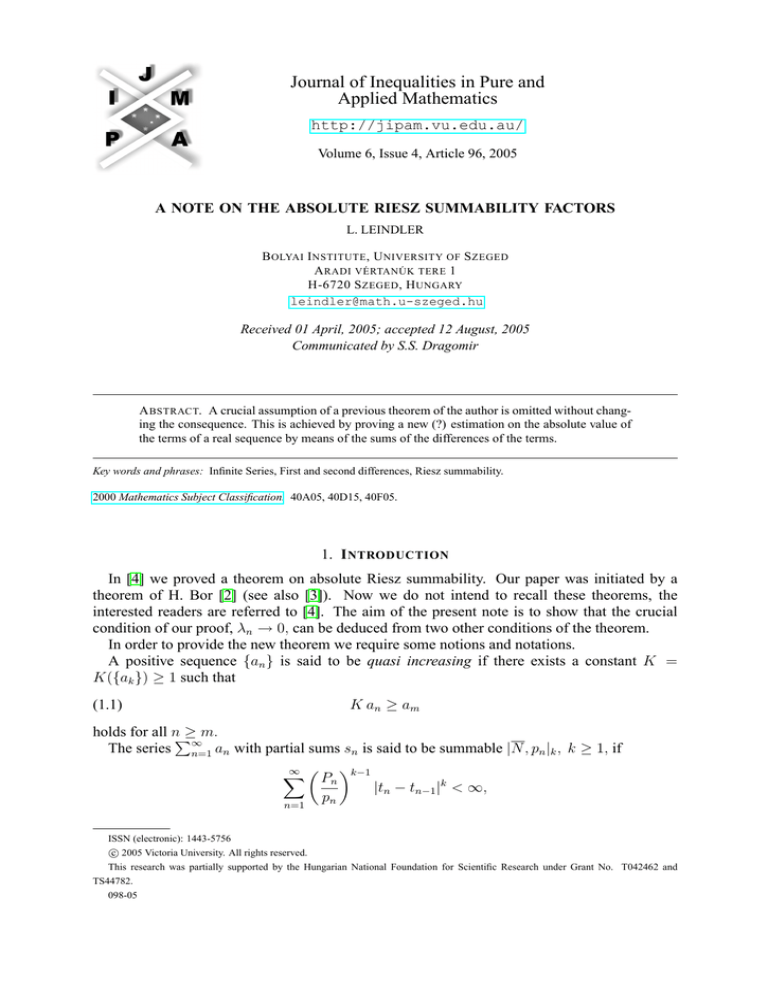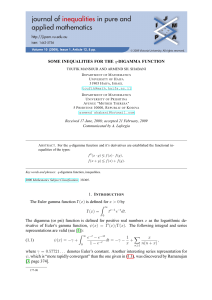
Journal of Inequalities in Pure and
Applied Mathematics
http://jipam.vu.edu.au/
Volume 6, Issue 4, Article 96, 2005
A NOTE ON THE ABSOLUTE RIESZ SUMMABILITY FACTORS
L. LEINDLER
B OLYAI I NSTITUTE , U NIVERSITY OF S ZEGED
A RADI VÉRTANÚK TERE 1
H-6720 S ZEGED , H UNGARY
leindler@math.u-szeged.hu
Received 01 April, 2005; accepted 12 August, 2005
Communicated by S.S. Dragomir
A BSTRACT. A crucial assumption of a previous theorem of the author is omitted without changing the consequence. This is achieved by proving a new (?) estimation on the absolute value of
the terms of a real sequence by means of the sums of the differences of the terms.
Key words and phrases: Infinite Series, First and second differences, Riesz summability.
2000 Mathematics Subject Classification. 40A05, 40D15, 40F05.
1. I NTRODUCTION
In [4] we proved a theorem on absolute Riesz summability. Our paper was initiated by a
theorem of H. Bor [2] (see also [3]). Now we do not intend to recall these theorems, the
interested readers are referred to [4]. The aim of the present note is to show that the crucial
condition of our proof, λn → 0, can be deduced from two other conditions of the theorem.
In order to provide the new theorem we require some notions and notations.
A positive sequence {an } is said to be quasi increasing if there exists a constant K =
K({ak }) ≥ 1 such that
(1.1)
K an ≥ am
holds for all nP≥ m.
The series ∞
n=1 an with partial sums sn is said to be summable |N , pn |k , k ≥ 1, if
k−1
∞ X
Pn
|tn − tn−1 |k < ∞,
p
n
n=1
ISSN (electronic): 1443-5756
c 2005 Victoria University. All rights reserved.
This research was partially supported by the Hungarian National Foundation for Scientific Research under Grant No. T042462 and
TS44782.
098-05
2
L. L EINDLER
where {pn } is a sequence of positive numbers such that
Pn :=
n
X
pν → ∞,
ν=0
and
n
1 X
p ν sν .
Pn ν=0
tn :=
2. R ESULT
As we have written above, the new theorem to be presented here deviates from our previous
result merely that an assumption, λn → 0, does not appear among the conditions.
The new theorem reads as follows.
Theorem 2.1. Let {λn } be a sequence of real numbers satisfying the condition
∞
X
1
|λn | < ∞.
n
n=1
(2.1)
Suppose that there exists a positive quasi increasing sequence {Xn } such that
(2.2)
∞
X
Xn |∆ λn | < ∞,
(∆ λn := λn − λn+1 ),
n=1
∗
Xm
(2.3)
m
X
1
:=
|tn |k = O(Xm ),
n
n=1
m
X
pn
|tn |k = O(Xm )
P
n
n=1
(2.4)
and
∞
X
(2.5)
n Xn∗ |∆(|∆ λn |)| < ∞
n=1
hold. Then the series
P
an λn is summable |N , pn |k , k ≥ 1.
It is clear that if we can verify first that the conditions (2.1) and (2.2) imply that λn → 0, then
the proof given in [4] is acceptable now, too. We shall follow this way.
3. L EMMAS
We need the following lemmas for the proof our statement.
Lemma 3.1 ([1, 2.2.2. p. 72]). If {µn } is a positive,
monotone increasing and tending to infinity
P
sequence, then the convergence of the series
un µ−1
n implies the estimate
(3.1)
n
X
uk = o(µn ).
k=1
This lemma is the famous Kronecker lemma.
J. Inequal. Pure and Appl. Math., 6(4) Art. 96, 2005
http://jipam.vu.edu.au/
A N OTE ON THE A BSOLUTE R IESZ S UMMABILITY FACTORS
3
Lemma 3.2. Let {γn } be a sequence of real numbers and denote
n
∞
X
X
Γn :=
γk and Rn :=
|∆ γk |.
k=1
k=n
If Γn = o(n) then there exists a natural number n0 such that
|γn | ≤ 2Rn
(3.2)
for all n ≥ n0 . Naturally R1 < ∞ is assumed, otherwise (3.2) is a triviality. However then
Γn = o(n) is not only sufficient but also necessary to (3.2).
Remark 3.3. It is clear that if γn → 0 then |γn | ≤ Rn is trivial, but not if γn 6→ 0, see e.g.
γn = c 6= 0 or γn = 2 − n1 . Perhaps (3.2) is known, but unfortunately I have not encountered it
in any paper. I presume that (3.2) is not very known, namely recently two papers used it without
the assumption Γn = o(n), or its consequences to be given next.
4. C OROLLARIES
Lemma 3.2 implies the following usable consequences.
Corollary 4.1. Let {ρn } be a sequence of real numbers. If ρn = o(n) then
∞
X
(4.1)
|∆ ρn | ≤ 2
|∆2 ρk |, (∆2 ρk = ∆(∆ ρk )).
k=n
holds if n is large enough.
Corollary 4.2. Let α ≥ 0 and {ρn } be as in Corollary 4.1. If
∞
X
(4.2)
k α |∆2 ρk | < ∞, (ρn = o(n)),
k=1
then
(4.3)
|∆ ρn | = o(n−α ).
In my view Lemma 3.2 and these corollaries are of independent interest.
5. P ROOFS
Proof of Lemma 3.2. Let us assume that (3.2) does not hold for any n0 . Then there exists an
increasing sequence {νn } of the natural numbers such that
(5.1)
2Rνn < |γνn |.
Let m = νn , and be fixed. Then for any k > m
k−1
X
2Rm < |γm | = ∆ γi + γk ≤ Rm + |γk |,
i=m
whence
(5.2)
Rm < |γk |
holds.
Now let us choose n such that
(5.3)
J. Inequal. Pure and Appl. Math., 6(4) Art. 96, 2005
(n − m)Rm > 2|Γm |.
http://jipam.vu.edu.au/
4
L. L EINDLER
It is easy to verify that for all k > m the terms γk have the same sign, that is, γk · γk+1 > 0.
Namely if γk and γk+1 have different sign then, by (5.2), |∆ γk | > 2Rm . But this contradicts the
fact that Rm ≥ Rk ≥ |∆ γk |.
Thus, if n > m then
n
X
Γn = Γm +
γk ,
k=m+1
and by invoking inequalities (5.2) and (5.3) we obtain that
|Γn | ≥
n
X
1
|γk | − |Γm | ≥ (n − m)Rm .
2
k=m+1
Since the last inequality opposes the assumption Γn = o(n), thus (3.2) is proved. To verify the
necessity of the condition Γn = o(n) it suffices to observe that R1 < ∞ implies Rn → 0, thus,
by (3.2),
n
1X
|γk | → 0
n k=1
clearly holds.
Proof of Corollary 4.1. Applying Lemma 3.2 with γn := ∆ ρn , we promptly get the statement
of Corollary 4.1.
Proof of Corollary 4.2. In view of (4.2) it is plain that
∞
X
|∆2 ρk | = o(n−α ),
k=n
whence (4.3) follows by (4.1).
Proof of Theorem 2.1. It is clearly sufficient to verify that the conditions (2.1) and (2.2) imply
that
λn → 0,
(5.4)
namely with this additional condition the assertion of Theorem 2.1Phad been proved in [4].
Now we prove (5.4). In view of Lemma 3.1 we know that nk=1 |λk | = o(n), thus the
assumptions of Lemma 3.2 are satisfied with γn := λn . Furthermore the condition (2.2) visibly
implies that
(5.5)
∞
X
|∆ λk | = o(1),
k=n
thus (3.2), by (5.5), proves (5.4).
The proof is complete.
R EFERENCES
[1] G. ALEXITS, Convergence Problems of Orthogonal Series. Pergamon Press 1961, ix+350 pp. (Orig.
German ed. Berlin 1960.)
[2] H. BOR, An application of almost increasing and δ-quasi-monotone sequences, J. Inequal. Pure and
Appl. Math., 1(2) (2000), Art. 18. [ONLINE: http://jipam.vu.edu.au/article.phd?
sid=112]
J. Inequal. Pure and Appl. Math., 6(4) Art. 96, 2005
http://jipam.vu.edu.au/
A N OTE ON THE A BSOLUTE R IESZ S UMMABILITY FACTORS
5
[3] H. BOR, Corrigendum on the paper “An application of almost increasing and δ-quasi-monotone
sequences", J. Inequal. Pure and Appl. Math., 3(1) (2002), Art. 16. [ONLINE: http://jipam.
vu.edu.au/article.phd?sid=168]
[4] L. LEINDLER, On the absolute Riesz summability factors, J. Inequal. Pure and Appl. Math., 5(2)
(2004), Art. 29. [ONLINE: http://jipam.vu.edu.au/article.phd?sid=376]
J. Inequal. Pure and Appl. Math., 6(4) Art. 96, 2005
http://jipam.vu.edu.au/












